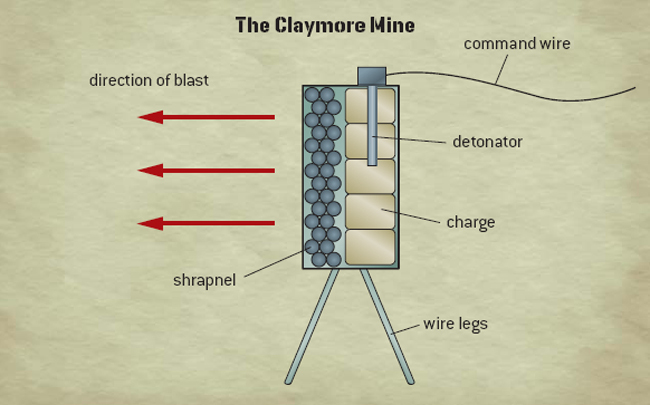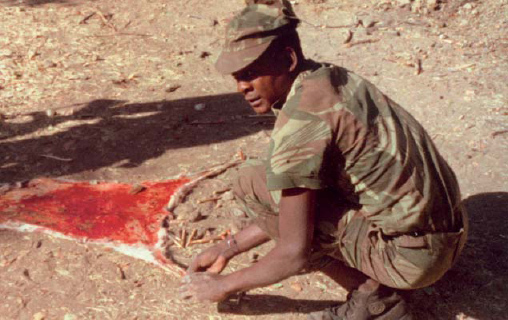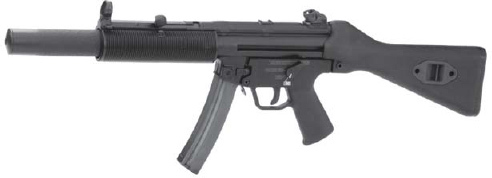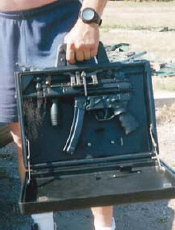Next attach the detonator by its two wires to the two (untwisted) ends of one end of the double wire. Always pick up a detonator by its wire. Do not ever touch a detonator body with your fingers. Body heat WILL set them off. Detonators are often referred to as ‘Two finger’, ‘Three finger’ and ‘Four Finger’ detonators for morbid reasons relating to how many fingers a particular size of detonator will remove cleanly.
When the detonator is attached to the wire, and you are ready to arm the Claymore, insert the detonator into the hole in the top of the casing. Retire briskly. The Claymore is fired by simply untwisting the wires at the command end and touching them onto a battery. If you do not use the Claymore and the urgency passes, you may want to keep it in position ready for the next night. Remember to take out the detonator at the first opportunity. Generally this will be done by the clearing patrols detailed later.
The safety tips for arming the Claymore pretty much apply to the use of all command detonated explosive devices with which you will come into contact. The thing about explosives is that your first mistake does not generally have the chance to make you careful as it is usually your last.


Corporal Ndlovu prepares the gazelle skin after the Claymore had done its damage – not sure what for as it was full of holes. (Author’s Collection)
I have often used the Claymore when defending small positions out in the ‘sticks’. Claymores are very light to carry, pack an immense punch and can act as a tireless sentry meaning extra sleep is an option. You just have to be very, very careful with them. It is all too easy to get careless when you are doing this procedure every day and are bone tired.
The procedure I adopt is to set up a Claymore pointing down each of the main approach tracks the enemy might use when creeping up on our position. And then attach them to a trip wire trigger. The mine would then be ‘covered’ by a machine gun as a gun should be placed in the position of expected approach in any event.
One night I was dosing behind the gun in my shell scrape when the Claymore to my front went off. It was pitch black, and the sentries had lost their night vision from the flash, but I loosed off 500 rounds into the area. There was no reply so I stopped firing. The next morning there was a small gazelle which had been well tenderized by both mine and gun. At least the poor little thing would have felt nothing. And it was not wasted. Actually, it was this same little creature I was cooking on a trip flare stake when mortared as mentioned previously.
Use of explosives in demolition
All armies have a demolitions course for soldiers who may need it. It is usually run by engineers who do this sort of thing all the time. The SAS and some other Special Forces units send all their men on a demolitions course as it is a useful skill if you are intent on disrupting an enemy’s lifestyle with very few men. You will doubtless understand why I am not about to teach you here how to demolish an office block with a can of oil or produce explosives in bulk from household materials or design cutting charges or place charges for maximum disruptive effect. Pass selection for Special Forces and you can do a proper demolition course.
Summary: What are the important things to remember about personal explosives?
Never touch a detonator with your fingers – hold it by the wire. Flares and Claymores make really good sentries but watch out for the back-blast from Claymores. Don’t get careless.
SUB-MACHINE GUNS
Sub-machine guns (SMGs) fire ‘automatic’ pistol ammunition with a true automatic fire option and are fed from a magazine. They have a longer range and higher rate of fire than a pistol but cannot easily be hidden. They do not have the range, rate of fire or hitting power of an automatic rifle so their use is extremely limited. The only time I can see a use for a sub-machine gun is in a role where it needs to be silenced. You will be aware that the subsonic pistol can be silenced where the supersonic rifle cannot because of the sonic crack made by the rifle bullet.
Goal: When is the right time to employ this weapon? What is it good for?
When would you want to fire a burst of pistol ammunition rather than a burst from a rifle? Are you a mafia enforcer wanting to shoot up another family’s bar from your Sedan? I find it difficult to imagine where you would use a sub-machine gun in a military situation. I know many SF teams are issued with them for use in house clearing but I remain to be convinced they have any advantage over a shortened assault rifle. Perhaps the lack of penetration, compared to rifles, is why so many police carry them.

A silenced Heckler and Koch MP5 SD TRH215526 sub-machine gun. The ‘MP’ designation is used because the Krauts, quite rightly, consider them machine pistols. (Cody)

Estonia: the SMG in this armoured case can be fired by a trigger in the handle. (Photo courtesy Sergeant Roy Mobsby)
Probably the only reason for ordinary soldiers to be carrying a sub-machine gun is if they are in a vehicle and don’t expect to use it. You might issue one to a clerk who was not practiced on a pistol so they might hit something. Hopefully the opposition. Tank crews used to carry sub-machine guns as they were short of room – there is surprisingly little room inside a tank. Feasibly air crew might do the same. Truck drivers do and shouldn’t. They are giving up the advantage of a rifle without sufficient cause. Imagine your soft-skinned convoy is ambushed and you dismount and take cover then return fire. The enemy are 300m away blatting at you with AK47s which means they are out of the range of your sub-machine gun. Damn.
The US military has produced a version of the M16 rifle, which is 40in long, with a carbine version of 30in for when much of the firing is expected to be done from vehicles or inside buildings. This is just the ticket. Someone is thinking straight.
If you were on an operation where you needed to kill sentries quietly from a distance then a silenced sub-machine gun would give you better firepower and range than a pistol. Just to make sure everyone understands here, all weapons can be silenced for muzzle flash and ‘thump’ but a rifle round makes a loud supersonic crack travelling through the air and renders silencing futile. All pistol and SMG rounds can be loaded to be subsonic and therefore not make a supersonic crack.
History: How did it develop to be the way it is?
The first sub-machine gun made its appearance at the end of World War I when rifles were bolt action and the rate of fire available was a distinct advantage. Between the wars various models were developed with the Thompson .45 being the most famous. This was fed from either a straight magazine or a drum capable of holding 50 rounds. By World War II with rifles still being mostly single shot, all the major armies developed sub-machine guns with the German Schmeisser, the British Sten and the US Grease gun being well known examples.
In Israel, Major Uziel Gal developed the Uzi sub-machine gun in the late 1940s and this heavy but small and efficient weapon became the standard by which all others were judged. At the present time there are a number of sub-machine guns in production with the emphasis being on small, light and high cyclic rate of fire. Some over 1,000 per minute. Glock actually produce an accessory for their pistols to convert into a sub-machine gun. I think this is more to cater for gung ho-amateurs than serious operators although the increased accurate range over a pistol, given by the stock, may give some advantage to bodyguards.